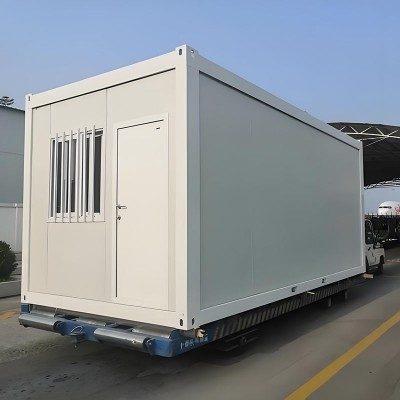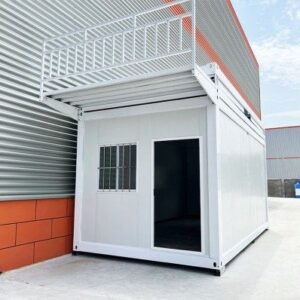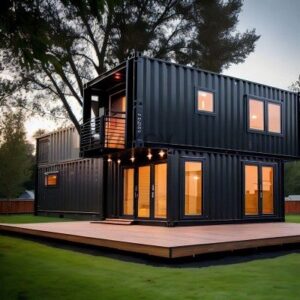What is a Shipping Container Home
A shipping container home is a house built primarily from steel shipping containers originally designed for cargo transport. These containers are repurposed and transformed into livable spaces through modifications such as cutting openings, adding insulation, plumbing, and electrical systems. This innovative approach to construction combines strength, affordability, and sustainability, offering an alternative to traditional homebuilding methods.
Types and Sizes of Shipping Containers Used in Construction
Shipping containers come in standard sizes, and most container homes use one or more of the following:
- 20-foot containerDimensions: about 20 feet long, 8 feet wide, 8.5 feet high
Ideal for small homes or single-room spaces - 40-foot containerDimensions: about 40 feet long, 8 feet wide, 8.5 feet high
Popular for larger rooms or combined living areas - 40-foot high cube containerSame length and width as a 40-foot container but with an extra foot of height (9.5 feet high)
Provides extra vertical space for more comfortable living areas
Containers can be stacked or combined side by side, allowing modular and flexible designs tailored to your needs.
Pros and Cons of Shipping Container Home Construction
Pros
- Durability: Containers are made of high-strength steel built to withstand harsh conditions, making them structurally sound homes.
- Quick construction: Building with containers can speed up the home construction process considerably.
- Cost-effective: Compared to traditional homes, container houses can be more affordable especially when sourcing used containers.
- Eco-friendly: Reusing containers promotes sustainability by reducing waste and using fewer raw building materials.
- Modularity: Containers can be easily combined or modified for flexible design options.
Cons
- Insulation challenges: Steel containers conduct heat and cold easily, so effective insulation is crucial for comfort and energy efficiency.
- Limited space: Standard container width (8 feet) can restrict interior layout and design options without combining multiple units.
- Permitting and zoning: Some local building codes and zoning laws may restrict or complicate container home construction.
- Structural modifications needed: Cutting out windows or doors reduces container strength and requires professional reinforcements.
- Corrosion risks: Proper treatment and maintenance are necessary to prevent rust and corrosion over time.
Understanding these factors at the start helps you make an informed decision about building a shipping container home that fits your lifestyle and budget.
Planning and Designing How to Build a House with Shipping Containers
Assessing Needs and Choosing Single or Multiple Containers
Before you start building a shipping container home, identify your needs and goals. Are you looking for a small, simple space or a larger family home? Single containers are good for tiny homes or studios, while multiple containers offer more room and design flexibility. Keep in mind:
- Single container homes are faster and cheaper to build but limited in size.
- Multiple container homes allow for creative layouts and separate rooms but need more planning and budget.
Designing Functional Layouts for Container Homes
Layouts must maximize the narrow dimensions (usually 8 feet wide) of containers. Focus on:
- Open floor plans to keep space feeling larger.
- Strategic placement of doors and windows to improve natural light.
- Efficient use of vertical space—think lofts or built-in storage.
- Combining containers side-by-side or stacking to create multi-room homes.
Architectural Considerations and Structural Modifications
Containers are strong but require modifications to fit your design. Some points to consider:
- Cutting openings for doors, windows, and interior access must maintain structural integrity.
- Reinforcements like steel beams may be needed when large sections are removed.
- Interior walls can be added for rooms, but they don’t carry structural load.
- Insulation is crucial since metal containers can get hot or cold quickly.
Using Professional Tools and Services for Better Design
While DIY plans are popular, professional tools and expert help can save trouble:
- CAD software and 3D modeling help visualize the final space and detect problems early.
- Hiring architects or designers familiar with container homes ensures your design is safe, functional, and compliant with codes.
- Professionals can also advise on structural changes, energy efficiency, and HVAC integration.
Popular Container House Designs and Case Studies
Looking at real examples helps inspire and guide your design. Some common successful layouts:
- Stacked containers with offset floors for multi-level living.
- U-shaped designs for creating courtyards or gardens inside.
- Single wide containers converted into open studio apartments with minimalist features.
- Modular container homes that combine several units for customizable spaces.
Examining these cases reveals how design choices impact comfort, efficiency, and cost. It’s smart to gather ideas from existing container home projects to shape your own plan.
Legal and Regulatory Considerations for Shipping Container Homes
When building a shipping container home, understanding the local zoning laws and building codes is a must. Regulations vary widely from state to state and even city to city across the United States, so it’s important to check the rules specific to your area early in the planning process.
Local Zoning Laws and Building Codes
Zoning laws control land use and can affect whether you can place a container home on your chosen lot. Some areas may restrict container homes to certain zones, like residential or mixed-use districts, while others might have outright bans. You’ll need to confirm if container homes are classified as permanent structures or considered temporary or modular housing under local laws.
Building codes also come into play, ensuring your container home meets safety and habitability standards:
- Structural integrity requirements
- Fire safety and egress standards
- Insulation and energy efficiency guidelines
- Electrical and plumbing codes
Because container homes are a relatively new concept, some regions may lack specific codes for them, requiring you to work with officials to get approvals using comparable standards.
Permits and Inspections Required
Before construction can start, obtaining the proper permits is essential. These usually include:
- Building permits
- Electrical and plumbing permits
- Mechanical permits for HVAC systems
Once the permits are secured, your container home will be subject to periodic inspections during different stages of construction. Inspectors will check that your project complies with approved plans and local building laws.
Working with Local Authorities and Consultants
Navigating the legal side can be complex. I recommend:
- Consulting with local building departments early to understand all requirements
- Hiring or working alongside professionals like architects and engineers familiar with container home codes
- Engaging third-party inspectors or consultants who specialize in modular or alternative building methods
This approach can save you time and prevent costly surprises, helping ensure your shipping container home project complies fully with building codes for container houses and local regulations.
For deeper insights on how to meet design and construction standards, check out detailed guides on shipping container home construction steps.

Preparing the Site and Foundation for Your Shipping Container House
Choosing the Perfect Location for a Shipping Container Home
Picking the right spot is crucial when building a shipping container home. You’ll want to consider:
- Accessibility: Proximity to roads, utilities, and emergency services
- Land slope and soil type: Flat, stable ground is ideal to minimize foundation issues
- Sun exposure and wind patterns: For natural lighting and energy efficiency
- Flood risk and drainage: Avoid flood-prone areas to protect your investment
- Local amenities and zoning restrictions: Check if your site complies with all local building codes
Taking time to thoroughly evaluate the site sets a solid foundation—literally—for your project.
Types of Foundations Suitable for Shipping Container Homes
Shipping container homes are versatile, but their weight and structure demand a strong foundation. Common foundation types include:
| Foundation Type | Description | Best For | Pros | Cons |
|---|---|---|---|---|
| Pier Foundation | Concrete piers spaced to support containers | Uneven or sloped terrain | Cost-effective, allows airflow underneath | Less insulation, potential for pests |
| Slab Foundation | Solid concrete slab covering full footprint | Flat, stable ground | Strong, easy to work on | More expensive, less drainage |
| Crawl Space | Raised foundation with accessible space below | Damp areas needing ventilation | Good insulation access, protects from moisture | Higher cost, requires maintenance |
Each foundation has its place depending on your site conditions and budget. Consulting with a local foundation expert can help you pick the best fit.
Site Preparation Checklist for Shipping Container Homes
Before placing your container, you’ll need to prep the site thoroughly. Here’s a checklist to keep things on track:
- Clear vegetation and debris
- Level the ground and grade for drainage
- Mark foundation points precisely
- Install utility hookups or plan for connections
- Arrange access paths for heavy equipment
- Ensure safety measures during construction
- Confirm permits and inspections are scheduled
Proper site preparation avoids delays and costly fixes during container installation.
Modifications and Construction Process for Shipping Container Homes
When it comes to building a home from shipping containers, the modification and construction phase is crucial. This stage transforms raw containers into a comfortable, livable space.
Cutting and Welding for Doors Windows and Openings
One of the first steps is cutting openings for doors, windows, and vents. This requires precision to maintain the structural strength of the container. Welding is used to reinforce cut edges and attach frames or structural supports around these openings. Using professional welding services is recommended to ensure safety and durability.
Structural Reinforcements and Insulation Options
Shipping containers are built strong but may need additional reinforcements depending on your design:
- Structural Reinforcements: Reinforce load-bearing walls if removing large sections for windows or combining multiple containers. Steel beams or braces often help maintain rigidity.
- Insulation Choices: Proper insulation is critical for comfort and energy efficiency. Options include:
- Spray foam insulation: Provides excellent coverage, seals air gaps, and acts as a moisture barrier.
- Insulation blankets: Cost-effective, easy to install, but may need additional vapor barriers.
- Rigid foam board: Good for tight spaces and adds structural strength.
For detailed insulation tips, you can explore how to insulate container house for energy savings.
Plumbing and Electrical Setup Considerations
Planning plumbing and electrical systems early is vital to avoid costly changes later:
- Install plumbing lines in insulated chases or inside walls to prevent freezing, especially in colder U.S. regions.
- Use certified electricians to ensure wiring meets local building codes.
- Consider energy-efficient fixtures and smart wiring systems for sustainability.
- Remember, containers have limited wall cavities, so creative routing might be necessary.
Roof Installation and Waterproofing
Adding a proper roof protects your container home from leaks and weather damage:
- Flat or sloped steel roofs can be welded or bolted on.
- Use high-quality waterproof membranes and sealants on joints and around openings.
- Consider adding green roofs or solar panels to improve sustainability and energy efficiency.
Interior Finishing Tips and Materials Suitable for Containers
For the interior, choose materials that work well with metal structures and limited space:
- Use lightweight drywall or plywood for walls and ceilings.
- Flooring options like vinyl, laminate, or engineered wood are practical and moisture-resistant.
- Opt for built-in or modular furniture to maximize space.
- Proper ventilation and moisture control are essential to prevent condensation.
Cost Estimation and Budgeting for Shipping Container Homes
Building a house with shipping containers can be affordable, but costs vary depending on your choices. Here’s a breakdown of what to expect:
Typical Costs Breakdown
- Container Purchase:
- Used 20-foot containers generally cost between $2,000 to $4,000.
- 40-foot containers can run $3,000 to $6,000 or more depending on condition.
- Modifications:
- Cutting openings for doors and windows, welding, and reinforcements usually add $10,000 to $20,000.
- Insulation and interior wall installation can cost another $5,000 to $15,000.
- Permits and Inspections:
- Fees vary by location; expect $1,000 to $5,000 depending on local building codes and zoning.
- Labor:
- Hiring professional builders or specialized contractors can range from $30 to $75+ per hour.
- DIY can save on labor but requires skill and time.
- Finishing:
- Flooring, cabinets, plumbing, and electrical may add $15,000 to $30,000 depending on quality and size.
How to Save Money Without Cutting Quality
- Buy used or repurposed containers that are structurally sound rather than new ones.
- DIY some parts like interior finishing or painting if you have the skills.
- Simplify your design to reduce modifications.
- Source materials locally to avoid shipping costs.
- Use cost-effective insulation options like spray foam that also provide energy savings.
Financing Options and Budgeting Tips
- Home improvement loans and personal loans are common routes for container home projects.
- Some lenders now consider container homes similar to modular or prefab homes, so look for specialized financing.
- Set a clear budget including a 10-15% buffer for unexpected costs.
- Get multiple quotes from contractors and suppliers.
- Plan for long-term savings by investing in energy efficiency like solar panels or high-quality insulation upfront.
Knowing your costs early helps manage expectations and keeps the project on track. Container homes can be a solid investment when you budget wisely and plan ahead.
Sustainability and Energy Efficiency in Shipping Container Homes
Building a shipping container home offers clear environmental benefits compared to traditional construction. Using repurposed containers reduces waste and lowers the demand for new building materials, making it a smart choice for eco-conscious homeowners. These homes also tend to have a smaller footprint and use less energy during construction.
Environmental Benefits of Container Homes
- Repurposing steel containers minimizes resource consumption and landfill waste.
- Lower construction time means reduced onsite emissions.
- Durable steel naturally resists pests and mold, reducing use of harmful chemicals.
- Compact design encourages minimalism and efficient living.
Incorporating Solar Panels Rainwater Harvesting and Green Tech
Adopting green technologies can make your container home even more energy efficient:
- Solar panels: Easily mounted on container roofs, solar panels provide clean electricity helping cut utility bills.
- Rainwater harvesting: Setting up gutters and storage tanks lets you collect rainwater for irrigation and non-potable uses, reducing water waste.
- Energy-efficient appliances and LED lighting: Lower overall electricity consumption.
- Green insulation materials: Use eco-friendly options like spray foam or rigid board insulation that improve thermal performance without toxic chemicals.
- Smart home systems: Manage energy use through programmable thermostats and energy monitors.
Tips for Maximizing Energy Efficiency
To make your container home as energy efficient as possible, focus on these key areas:
- Proper insulation and ventilation to control indoor temperature and reduce heating/cooling needs.
- Use high-quality windows and doors with good seals to prevent heat loss.
- Position containers respecting natural sunlight for passive solar heating and daylighting.
- Add shade structures or reflectors to keep the home cool in summer.
- Choose energy-efficient HVAC systems, tailored to the compact and metal structure.
- Regular maintenance of seals and insulation to preserve energy performance.
By combining recycled container structures with green tech and smart energy use, you build a home that’s both sustainable and comfortable for everyday living.
How to Build a House with Shipping Containers and How to Overcome Them
Building a house from shipping containers comes with unique challenges. Knowing these ahead of time can save you headaches during construction and later living comfort.
Structural Limitations and How to Address Them
Shipping containers are strong but designed for stacking, not for open layouts or heavy modifications. Here’s how to work around structural concerns:
- Reinforce cut areas: When creating doors, windows, or combining multiple containers, cut sections can weaken the structure. Add steel beams or frames around openings to maintain integrity.
- Consult structural engineers: Always get expert advice when making major changes to avoid compromising strength.
- Plan load distribution: Containers bear weight mostly on corners, so plan your design and foundation to support those points.
- Account for stacking: If building multiple stories, ensure lower containers can support the upper load with added reinforcements.
Dealing with Condensation and Ventilation
Condensation inside container homes is a widespread issue due to metal surfaces reacting to temperature shifts. Poor ventilation can cause mold, rust, and discomfort.
To combat this:
- Use high-quality insulation: Spray foam or rigid board insulation helps regulate temperature and reduce condensation.
- Install vapor barriers: These prevent moisture from seeping through walls.
- Incorporate proper ventilation: Add vents, windows, or mechanical ventilation systems to keep air flowing.
- Consider dehumidifiers: In humid climates, these can manage moisture levels inside.
Shipping Container Sourcing and Quality Concerns
Finding the right shipping containers is a foundational step, but it’s not always straightforward:
- Check container history: Avoid containers that carried toxic or hazardous materials.
- Inspect for damage and rust: Look for structural issues that may cost more to fix later.
- Choose from trusted suppliers: Reputable dealers can offer warranties and certifications for quality.
- Consider refurbished vs. new: New containers cost more but usually need fewer repairs. Refurbished can save money but require thorough inspection.
Proper sourcing ensures your container home starts with a solid base, saving time and money in the long run.
For detailed advice on modifying containers into functional homes, visit this guide on how to convert shipping container to house.
Final Touches and Moving In Shipping Container Homes
Furnishing a Shipping Container Home for Comfort and Style
When it’s time to furnish your shipping container home, think compact, functional, and stylish. Containers have limited space, so opt for multi-purpose furniture like sofa beds, fold-out tables, and built-in storage units to maximize every inch.
- Use light-colored furniture and decor to open up the space visually.
- Consider modular furniture that can be rearranged easily.
- Add soft textures like rugs, cushions, and curtains to counter the industrial feel of metal walls.
- Don’t forget proper lighting—layered lighting with warm tones helps make the space inviting.
Landscape and Exterior Aesthetics
To enhance curb appeal and blend your container home into its surroundings, focus on landscaping and exterior treatments.
- Use native plants and shrubs that thrive locally and require less water.
- Add decking or patios to expand outdoor living space.
- Consider paint or cladding on the container exterior to improve insulation and appearance.
- Incorporate shading elements like pergolas or awnings to reduce heat gain.
- Install pathways and outdoor lighting for both safety and style.
Maintenance Tips for Long Term Durability
Keeping your shipping container house in good shape requires regular upkeep, especially since metal containers are prone to rust and wear.
- Inspect and touch up the exterior paint every few years to prevent rust.
- Keep gutters and drainage clear to avoid water pooling.
- Check seals around doors and windows to maintain insulation and prevent leaks.
- Maintain HVAC, plumbing, and electrical systems regularly.
- Address any dents or structural damage promptly to avoid weakening the container.
Following these steps will help your shipping container home stay comfortable, efficient, and attractive for years to come.
Inspiration and Resources for Shipping Container Homes
If you’re looking for ideas and reliable help to build your container home, there are plenty of resources and experts ready to guide you.
Gallery of Inspiring Shipping Container Homes
Seeing real examples can spark great ideas. Check out these popular sources for design inspiration:
- Pinterest and Instagram: Search “shipping container home design ideas” or “modular shipping container homes” to find photo galleries and creative layouts.
- Architectural websites: Sites like ArchDaily and Houzz feature detailed projects that show how containers can be creatively transformed.
- YouTube channels: Many DIY builders document their shipping container house construction, giving you step-by-step insights and practical tips.
Recommended Suppliers and Contractors
Choosing the right professionals and suppliers is key. Look for:
- Specialized container home builders: Companies that focus solely on container modifications and structural reinforcements.
- Local architects familiar with container home codes: They can help navigate permits and design for your area’s zoning laws.
- Container suppliers with quality guarantees: A reliable shipping container seller ensures you get structurally sound containers, avoiding rust and damage issues.
Some well-known U.S. suppliers and builders:
| Supplier/Builder | Specialty | Website |
|---|---|---|
| Container Homes USA | Custom container home builds | containerhomesusa.com |
| MOD Container Homes | Modular container home designs | modcontainerhomes.com |
| SG Blocks | Shipping container commercial and residential | sgblocks.com |
Useful Online Communities and Further Reading
Engaging with communities helps answer questions, spot trends, and avoid common pitfalls:
- Reddit’s r/ShippingContainers and r/ContainerHomes: Active forums for sharing experiences and advice.
- Facebook groups like “Shipping Container Home Builders” offer peer support and recommendations.
- Books and eGuides:
- Shipping Container Homes for Beginners by Daniel McCarthy
- The Modular Home by Andrew Gianino – covers container and prefab home basics.
- Blogs: Websites such as Tiny House Talk and The Container Home Guide provide regular updates on container home innovations and tips.
These resources are designed to give you a comprehensive view of shipping container home design, construction, and living — making your container home journey smoother and better informed



